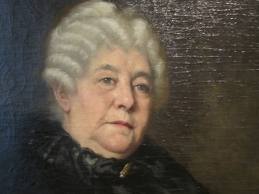Last month I visited the Women’s Rights National Historical Park in Seneca Falls, New York, around the anniversary of the town’s most famous event, the 1848 women’s rights convention. Called by Elizabeth Cady Stanton and Lucretia Mott and colleagues, the meeting convened in hot July at the Wesleyan Chapel. This was a seminal gathering, drawing together women and men who had been active in other causes: Frederick Douglass and Amelia Bloomer, Methodists and Quakers, movers in temperance, anti-slavery, missionary ventures. Church communities were significant in the movement, in support and opposition, though some of its leaders departed from traditional Christianity (Stanton late in life helped write a Woman’s Bible). Echoing the Declaration of Independence, the convention ratified a Declaration of Sentiments, with resolutions like these:
Resolved, That the women of this country ought to be enlightened in regard to the laws under which they live, that they may no longer publish their degradation, by declaring themselves satisfied with their present position, nor their ignorance, by asserting that they have all the rights they want….
Resolved, That it is the duty of the women of this country to secure to themselves their sacred right to the elective franchise.
The centerpiece of the Seneca Falls site is its museum, packing much fascinating material into the small space, mostly driving a narrative of equality. Worthy items and themes, but a missed opportunity to consider questions integral to the 1848 meeting. Commemoration of women’s call for the vote should needle visitors to consider the meaning of citizenship, who qualifies, what it demands–rather than praise an ideal of equality to which all visitors are already presumed to ascribe.
The National Park Service (NPS) park map guiding visitors around Seneca Falls is titled “Burn While You Learn.” Burn what? Is the map making reference to this tract of upstate New York nicknamed the “Burned Over” district, because so many revivalists came through preaching in early nineteenth century? A reference to the burning watch-fires in the “Battle Hymn of the Republic”?
No. Calories. Prompting visitors to blend civic education with fitness, the map gives estimates of calories burned by walkers strolling from one building to the next. (Not many: it’s a small town.) Fitness is fine and mental multi-tasking is fine. There are a few other NPS sites do this, the rangers at this museum told me, but were proud to claim it as a distinction of theirs.
In recent years the National Park Service has joined goals of public health and environmental sustainability in a “Healthy Parks, Healthy People” initiative. Consistent logic links public parks with anti-obesity campaigns. But this park’s integration of fitness programs is particularly infelicitous. Calorie counts sit awkwardly with exhibits, here touting women’s efforts to serve in political and professional spheres, there showing skeletal distortion wrought by corsets.
Perhaps I am finding offense where none was meant. Even if weight-loss tips are directed to men, women, and children equally, they are out of place here. Some National Parks feature wild landscapes, canyons, forests; those parks suitably could prioritize fitness. But the history parks are directed to civic education, appreciation, commemoration. There is a full-skirted nanny-state feel to being coached on exercise a the same time as reading about voting laws and garment-workers safety.
Citizenship, justice, and equality are quite enough to occupy the mind without having to consider burning off a donut at the same time.













